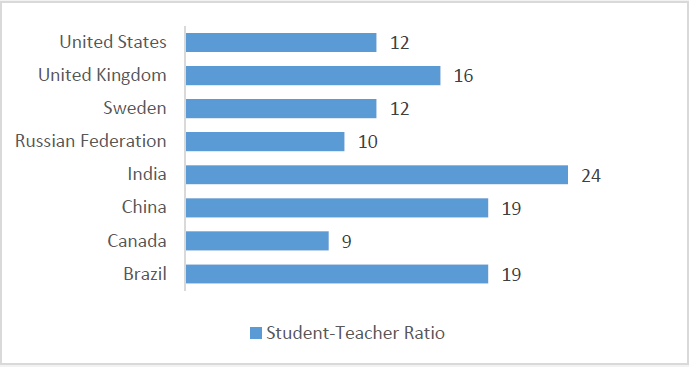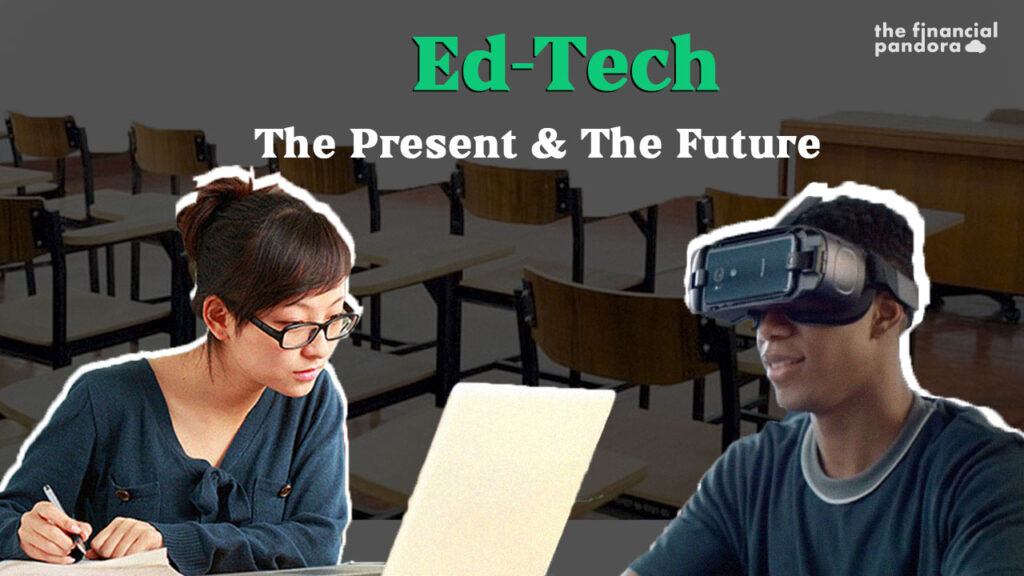The education system in India has been facing chronic problems from the ground-up. Little or no modification has been brought about by the authorities for age-old issues. Many educational institutes in India have been following the “teach what is taught” model since ages – professors impart the same knowledge that they received years ago when they were students themselves. Syllabuses have not been updated quickly enough to bring them at par with the current industry requirements.
According to a report by the Education Quality Upgradation and Inclusion Programme (EQUIP), the student-teacher ratio in India was the lowest (24:1) among the evaluated countries.

The report stated, “…A low student-teacher ratio indicates the burden on a single teacher of teaching multiple students as well as the lack of time that each student gets. Apart from this simplistic effect, in an institution of higher learning, a smaller number of and overburdened teachers are also unable to pursue any research or encourage their students to do so. Consequently, the culture of questioning and reasoning cannot be inculcated as a part of higher education in most institution …”.
So true! As students, most of us went through those moments when some of the brightest students would answer questions in class, and we would sit dumbfounded with lots of queries running through our minds. Most students never bothered to take those queries to their professors.
The outdated syllabus, difficulties in resolving queries and the fact that practice of reasoning is not inculcated – all of this leads to rote learning among students. While conceptual learning has been gaining momentum in some institutes, it is still not rooted deep enough throughout our country.
Rise of The Ed-Tech
A few years ago, there seemed no solutions to many of these problems, until some millennials felt the dire need to solve them. They then started creating educational content with conceptual learning being the focus. Along with quality, there was also a need to scale-up the business, so they clubbed it with technology − thus reaching a mass of students, and the rise of the ed-tech start-ups finally began!
What Could Have Possibly Attracted Investors?
India is now home to numerous ed-tech start-ups and the number of players in this space is only increasing. However, not many have proved to be successful. Among these start-ups, BYJU’s has been the most successful in attracting funding from multiple investors. After the last investment by Mary Meeker founded VC fund Bond Capital, Byju’s is now a “decacorn” with a valuation of a whopping $10.5Bn – indeed a proud moment for the Indian education space!
Investors who have invested in the ed-tech space have recognised global trends that will continue to drive growth. Some of these include:
- Growing population in developing countries
- Rising demand for educational technology and services
- Increasing digitization to improve outcomes and efficiency
- Opportunities to solve key problems in the industry (rote learning, employable skills, student debt, etc.)
Last but not the least, the COVID-19 era! No matter how ugly, it is acting as a catalyst for ed-tech businesses. Even in India, where the brick and mortar model has been holding its ground in the education space, investors are foreseeing ed-tech as the next revolution! According to data collated by UNESCO, more than 1.2 bn students, in more than 180 countries faced school closures in April 2020, and 320 mn of those were in India.
A study of some of the major online learning platforms showed that in the first 28 days of lockdown in India, the ed-tech segment saw 128.8 mn visits (4.6 mn average daily visits), as compared to 102.2 mn visits between April 2019 to Feb 2020.
According to Omidyar Network India’s research in 2017, half a billion new users are expected to come online for the first time by 2022, and the majority of this half billion would access the internet through mobile phones. Well, I’m sure they didn’t factor the current black-swan event we are facing – which will escalate the speed at which the said half-a-billion population joins the ed-tech user base!
During these times when technology is the most important medium of communication and businesses are heavily dependent on it, the ed-tech space is proving itself to be winning in the race of “survival of the fittest”. Having said that, while investors are all gung-ho about investing in this space, there are several aspects regarding the present and future of ed-tech which are worth pondering upon. Let’s deal with them one by one.
The Customer and The Consumer
Education is a very tricky sector and ed-tech is even trickier. A problem that differentiates ed-tech from other tech start-ups is that the customer and consumer are not always the same. In the case of ed-tech start-ups which focus on school-level learning, students are the consumers, whereas parents are the customers – for most of the child’s schooling. It may so happen, that the parents purchase courses offered by one platform, say from 5th to 7th grade, post which the students may find themselves capable enough to decide for themselves and shift to another platform, based on their personal preferences. Considering the low switching costs, it would be easy for parents and students to switch.
That being said, the retention rates of students in the online schooling space are a different ball game as compared to traditional schools!
Brand Loyalty Vs Faculty Loyalty
Another aspect which may hamper retention is brand loyalty vs faculty loyalty. In the ed-tech space, while brand matters, the loyalty of students towards their faculty matters equally.
We all had that one teacher in school/college whom we just loved because of their teaching methods. Now, since online education is flexible, if a faculty moves to another platform, so can students – depending on how much they value their knowledge/teaching style. This is similar to the problems restaurants face when they are unable to retain their head chef!
A student in a brick and mortar school/college may not change the school/college just because one faculty changed, and this is due to several challenges like admission procedures, transportation and friends, to name a few.
To increase their customer lifetime value, several ed-tech platforms like BYJU’s are providing multi-year subscription models. In contrast, another platform – Chegg, provides a pay-as-you-go model, which helps them retain students as they pay only for the assistance they need, and not for a monthly or yearly subscription. Other’s like UpGrad are tying-up with reputed institutes like IIIT Bangalore and IIT Madras which help them command higher fees too!
Another model being tested is an income-sharing agreement (ISA)! Start-ups like PestoTech are already up and running on this model. ISA is a contract between the educational platform and the student, whereby the former provides educational services in exchange for a defined percentage of the student’s future income, upon completion of the program.
Will Students Be Able To Spend Long Hours On Screens?
If the world wouldn’t have seen lockdowns, the answer could have probably been “not so soon!”. The reason for this would be that most parents play a big part in the education of their child, and they would be uncomfortable seeing their kids spending long hours on screen. According to a recent survey of kids in the age group of 5 – 15 years in India, it was observed that the screen time of kids had shot up by 100% since the first lockdown. 54% of the parents of these kids stated that their kids were spending five additional hours on screen, compared to pre-lockdown times. While this could have health repercussions, the online education industry which had no simple way of attracting students to study online is finding the lockdown a boon!
While acceptance of learning on screen in normal circumstances would have taken a long time, the current scenario is compelling students to learn online and spend longer hours exposing themselves to the screen. Even if this lasts for only a few months, they are expected to adapt to it eventually.
Some Known Issues
Credential & certificates: Certain MOOC (massive open online courses) platforms provide skill-based learning courses and provide the course-takers with a certificate or credential after the course. While the popularity of such additional credentials has been gaining momentum, most employers still demand a conventional degree from a recognised board. Tackling this will require receptivity from business leaders towards new MOOC–offerings, and it will be interesting to see how start-ups make that possible!
Completion rates: Studies have shown that MOOCs have always had abysmal completion rates since the beginning. The reason is that such courses are self-paced and many lack the self-motivation to complete them. The pandemic has added millions to online learning, and this should improve completion rates, but the stability of such improved rates will need to be evaluated once conditions go back to normal.
Digital divide: With the most economical data plans globally, India’s half-a-billion users make it the second-largest online market in the world, ranked only behind China. However, uninterrupted network connectivity is still a problem in rural India. While mobile phones are available and data is inexpensive, it’s not an easy task to spend hours online using a weak mobile data connection.
Free learning: First and foremost, many generous people teach online at no cost. They do so with the ideology that education should be free. But for students, finding free online courses to suit their needs can be a gruesome task. Ed-tech start-ups can capitalise this by providing curated content, which would, in turn, create value for students to use their platforms, and thus pay for them. As easy as it sounds, it requires time, money, marketing and a lot of creativity to get this done!
Universities Vs Ed-Tech Start-ups: Do They Really Need To Compete?
Up until now, I wasn’t positive on the thought of ed-tech start-ups even coming close to replacing universities, and I am sure many of us think the same. However, a recent announcement by Moody’s may change the way we think. The research announcement stated the following:
The virus outbreak will negatively affect finances at rated universities in the US, Canada, UK, Australia, Singapore and Mexico this year. Lower than expected enrolments will reduce tuition fee income and put pressure on institutions’ budgets. While the ability to shift teaching and assessment online varies, in general, students and academic staff have transitioned to online teaching and assessment and most rated universities will receive full or near full tuition fee income for the remainder of the current academic year (Source: Moody’s.com).
Simply put, schools/colleges are shut down and students may not be willing to pay huge sums to learn off-campus, on online platforms. This is causing some of the best universities around the globe to face a debt crisis! While many educational institutes can sustain by adopting new technologies, others are worried that they won’t be able to survive this crisis!
In such a scenario, ed-tech start-ups, which aim at providing a low-cost, high-quality learning experience should get an edge, right? But the brick and mortar learning model has been deep-rooted, hence a total replacement of universities is still a far-fetched thought. Most might agree that learning online would be possible to an extent, but the on-campus interpersonal skills like networking and building emotional connections with peers could not be possibly learnt through online platforms.
Besides, education start-ups are not the only ones upgrading themselves with technology. Certain universities and institutes have also been gearing themselves up with the latest tech solutions for some years now! In India, though the penetration of technology in schools/colleges is not deep, it has certainly started gaining momentum! The Indian government has become sensitized towards e-learning, and they are now emphasising the use of technology in the education sector.
On a global level, some universities are using state-of-the-art technology that can replace the engagement that students experience in a traditional classroom-learning session. Not only does this make it easier for the professors to pay attention to each student, but it also makes it possible for students all across the world to participate! Exciting to hear, isn’t it? Have a look at these videos to see this amazing technology in action:
- The Engaged Learning Online (“ELO”) technology platform adopted by S P Jain Global
- Harvard’s HBX – by Harvard University
- IE Business School’s WOW Room
It looks like universities and start-ups may become a competition with each other, isn’t it? In the education space, unlike other industries, co-existence rather than the competition could prove to be more fruitful!
Co-Existence As A Way Forward
The adoption of technology by schools and colleges would create an additional financial burden on institutes, and this would trickle-down to students. Besides, simply using laptops/computers does not mean the quality of education will improve. Content and delivery styles will have to be redesigned to ensure that digitisation is bringing value to the students. Also, if schools and colleges were to adopt technology as outstanding as ELO, Harvard HBX or the WOW Room, it would cost them a fortune!
Considering this, it could be mutually beneficial for start-ups and universities to coexist, rather than compete against each other. Along with several other benefits, leveraging this technology will enable teachers to provide more attention to students and address their doubts. This has been one of the key problems in brick and mortar institutes due to low student-teacher ratios.
But can an ecosystem with such coexistence be designed? Of course, it can, but it will need the start-ups, the universities and the government to work in tandem towards achieving this goal. In a scenario where this collaboration is achieved, what could the benefits be?
- Deeper penetration of technology in the education sector at the pan India level
- Economical technology solutions
- A higher level of acceptance among parents and students
- Skill development through unconventional courses parallel to traditional institutional learning
Using technology in the education sector is expected to generate returns that will shoot past the costs incurred to adopt it. Having said that, a blend of traditional institutional learning, with the support of ed-tech platforms would create the perfect moat for investors to invest their capital and for students to invest their time.
Follow Us @




